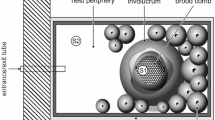Abstract
The diapause response of the Kanzawa spider mite (KSM), Tetranychus kanzawai, was examined. KSMs were reared in aluminum bottles at 18°C with different combinations of light and dark periods created by the light-control unit. The developmental periods for all immature stages tended to decrease as the light period increased. The photoperiodic response curve for diapause induction showed that the critical (=50% diapause) light period was around 13 h days−1. No diapause induction was observed when the light period was longer than 13.5 h days−1 or under continuous light. At 13-h days−1 light period, the developmental period for deutonymphal stage as well as for the total immature stages was longer in diapaused females than in non-diapaused females. These results indicate that immature development as well as diapause induction are affected by photoperiod and further suggest that diapause-inducing stimuli prolong the developmental period especially for the deutonymphal stage of KSMs.



Similar content being viewed by others
References
Danilevsky AS, Goryshin NI, Tyshchenko VP (1970) Biological rhythms in terrestrial arthropods. Annu Rev Entomol 15:201–244
Danks HV (1987) Insect dormancy: an ecological perspective. Biological survey of Canada (Terrestrial arthropods), National Museum of Natural Science, Ottawa. 439 pp
Gotoh T (1986) Annual life cycle of the two-spotted spider mite, Tetranychus urticae Koch (Acarina: Tetranychidae), on Ribes rubrum L. in Sapporo: the presence of non-diapausing individuals. Appl Entomol Zool 21:454–460
Ito K (2003) Effect of leaf condition on diapause induction of a Kanzawa spider mite, Tetranychus kanzawai Kishida (Acari: Tetranychidae) population on tea plants. Appl Entomol Zool 38:559–563
Ito K (2005) Development times under long- and short-day conditions in the Kanzawa spider mite Tetranychus kanzawai (Acari: Tetranychidae). Exp Appl Acarol 36:291–304
Ito K (2010) Effect of host plants on diapause induction in immature and adult Tetranychus kanzawai (Acari: Tetranychidae). Exp Appl Acarol 52:11–17
Ito K, Saito Y (2006) Effects of host-plant species on diapause induction of the Kanzawa spider mite, Tetranychus kanzawai. Entomol Exp Appl 121:177–184
Mochizuki M, Takafuji A (1996) Effect of photoperiod and temperature on the diapause termination of the Kanzawa spider mite, Tetranychus kanzawai Kishida (Acari: Tetranychidae). J Acarol Soc Jpn 5:83–88
Morishita M, Takafuji A (1999) Diapause characteristics of the Kanzawa spider mite, Tetranychus kanzawai Kishida, in pea fields of Central Wakayama Prefecture, Japan. Jpn J Appl Entomol Zool 43:185–188 (In Japanese with an English abstract)
Parr WJ, Hussey NW (1966) Diapause in the glasshouse red spider mite (Tetranychus urticae Koch): a synthesis of present knowledge. Hort Res 6:1–21
Suzuki T, Takeda M (2009) Diapause-inducing signals prolong nymphal development in the two-spotted spider mite Tetranychus urticae. Physiol Entomol 34:278–283
Suzuki T, Amano H, Goto E, Takeda M, Kozai T (2007) Effects of extending the light phase on diapause induction in a Japanese population of the two-spotted spider mite, Tetranychus urticae. Exp Appl Acarol 42:131–138
Takafuji A, Gotoh T (1999) Diapause characteristics of some Tetranychus (Acari: Tetranychidae) mites of Okinawa Island. J Acarol Soc Jpn 8:51–54
Takafuji A, Santoso S, Hinomoto N (2001) Host-related differences in diapause characteristics of different geographical populations of the Kanzawa spider mite, Tetranychus kanzawai Kishida (Acari: Tetranychidae), in Japan. Appl Entomol Zool 36:177–184
Takafuji A, Santoso S, Hinomoto N, Chain-Ing TS, Chyi-Chen H, Gotoh T (2003) Diapause characteristics of two species of tetranychids mites (Acari: Tetranychidae) in southern Japan and Taiwan. Appl Entomol Zool 38:225–232
Takeda M (1986) A circadian clock controlling cricket photoperiodism: a resonance effect? J Insect Physiol 32:557–560
Tauber MJ, Tauber CA, Masaki S (1986) Seasonal adaptations of insects. Oxford University Press, Oxford, p 411
Uchida M (1980) Appearance time of diapausing females and termination of diapause in the two-spotted spider mite, Tetranychus urticae Koch and the Kanzawa spider mite Tetranychus kanzawai Kishida on pear tree in Tottori District (Acarina: Tetranychidae). Jpn J Appl Entomol Zool 24:175–183 (In Japanese with an English abstract)
Van Houten YM, Overmeer WPG, Van Zon AQ, Veerman A (1988) Thermoperiodic induction of diapause in the predacious mite, Amblyseius potentillae. J Insect Physiol 34:285–290
Veerman A (1977) Aspects of the induction of diapause in a laboratory strain of the mite, Tetranychus urticae. J Insect Physiol 23:703–711
Veerman A (1985) Diapause. In: Helle W, Sabelis MW (eds) Spider mites: their biology, natural enemies and control, vol 1A. Elsevier, Amsterdam
Acknowledgments
This study was supported by Grants-in-Aid for Scientific Research (C) (21580062) and for JSPS Fellows (22-2650) from the Ministry of Education, Culture, Sports, Science and Technology, Japan. The authors thank Dr. T. Gotoh of Ibaraki University for kindly providing the study population. Thanks are also extended to M. Ohyama for providing technical support in the development of a low-cost plant growth chamber as well as computer software for regulating the photoperiods within the photoperiodic bottles.
Author information
Authors and Affiliations
Corresponding author
Rights and permissions
About this article
Cite this article
Shah, M., Suzuki, T., Ghazy, N.A. et al. Effect of photoperiod on immature development and diapause induction in the Kanzawa spider mite, Tetranychus kanzawai (Acari: Tetranychidae). Exp Appl Acarol 55, 183–190 (2011). https://doi.org/10.1007/s10493-011-9462-4
Received:
Accepted:
Published:
Issue Date:
DOI: https://doi.org/10.1007/s10493-011-9462-4




